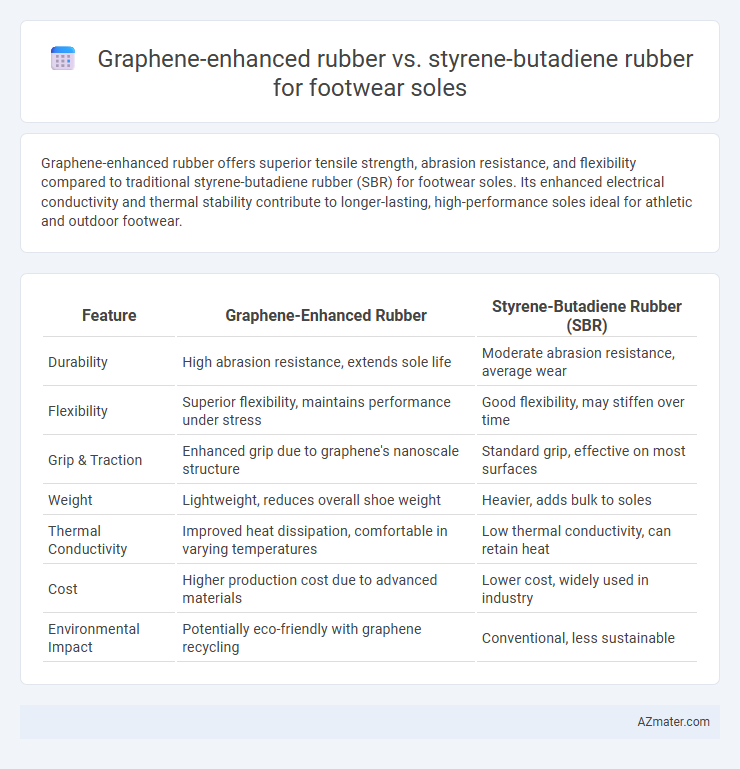Graphene-enhanced rubber offers superior tensile strength, abrasion resistance, and flexibility compared to traditional styrene-butadiene rubber (SBR) for footwear soles. Its enhanced electrical conductivity and thermal stability contribute to longer-lasting, high-performance soles ideal for athletic and outdoor footwear.
Table of Comparison
| Feature | Graphene-Enhanced Rubber | Styrene-Butadiene Rubber (SBR) |
|---|---|---|
| Durability | High abrasion resistance, extends sole life | Moderate abrasion resistance, average wear |
| Flexibility | Superior flexibility, maintains performance under stress | Good flexibility, may stiffen over time |
| Grip & Traction | Enhanced grip due to graphene's nanoscale structure | Standard grip, effective on most surfaces |
| Weight | Lightweight, reduces overall shoe weight | Heavier, adds bulk to soles |
| Thermal Conductivity | Improved heat dissipation, comfortable in varying temperatures | Low thermal conductivity, can retain heat |
| Cost | Higher production cost due to advanced materials | Lower cost, widely used in industry |
| Environmental Impact | Potentially eco-friendly with graphene recycling | Conventional, less sustainable |
Introduction to Footwear Sole Materials
Graphene-enhanced rubber offers superior mechanical strength, abrasion resistance, and flexibility compared to traditional styrene-butadiene rubber (SBR), making it an innovative choice for footwear sole materials. SBR is widely used due to its cost-effectiveness and good wear resistance but lacks the enhanced durability and conductivity properties found in graphene composites. Incorporating graphene into rubber compounds improves the overall performance of footwear soles by providing better grip, longevity, and responsiveness under various environmental conditions.
What is Graphene-Enhanced Rubber?
Graphene-enhanced rubber incorporates graphene, a single layer of carbon atoms arranged in a hexagonal lattice, to significantly improve mechanical strength, flexibility, and wear resistance compared to traditional styrene-butadiene rubber (SBR). This advanced material offers superior durability, enhanced traction, and better thermal conductivity, making it ideal for high-performance footwear soles. The integration of graphene results in longer-lasting, more comfortable shoes with improved resistance to abrasion and environmental degradation.
Understanding Styrene-Butadiene Rubber (SBR)
Styrene-butadiene rubber (SBR) is a synthetic elastomer widely used in footwear soles due to its excellent abrasion resistance and good aging stability. Its copolymer structure, combining styrene and butadiene monomers, provides a balance of hardness and flexibility essential for durable, comfortable shoe soles. Compared to graphene-enhanced rubber, SBR offers cost-effective performance but lacks the superior strength, thermal conductivity, and wear resistance imparted by graphene composites in advanced footwear applications.
Mechanical Strength Comparison
Graphene-enhanced rubber exhibits significantly higher tensile strength and abrasion resistance compared to traditional styrene-butadiene rubber (SBR), making it ideal for durable footwear soles. The incorporation of graphene nanosheets increases the modulus and tear strength, resulting in improved mechanical performance under stress and prolonged sole lifespan. Testing shows graphene composites can achieve up to 30% greater mechanical strength than SBR, enhancing wear resistance and flexibility simultaneously.
Durability and Wear Resistance
Graphene-enhanced rubber exhibits superior durability and wear resistance compared to traditional styrene-butadiene rubber (SBR) in footwear soles due to its exceptional mechanical strength and high tensile properties. Incorporating graphene nanoparticles improves abrasion resistance, resulting in longer-lasting soles that maintain structural integrity under repetitive stress. This advanced composite material reduces wear rate significantly, enhancing shoe performance and lifespan in demanding environments.
Comfort and Flexibility Factors
Graphene-enhanced rubber exhibits superior comfort and flexibility compared to traditional styrene-butadiene rubber in footwear soles due to its exceptional tensile strength and elasticity. The incorporation of graphene nanoparticles improves the material's resilience and shock absorption, enhancing wearer comfort during prolonged use. Flexibility in graphene-enhanced soles allows for better foot movement and reduced stiffness, making them ideal for ergonomic footwear designs.
Traction and Slip Resistance
Graphene-enhanced rubber significantly improves traction and slip resistance in footwear soles by providing a higher surface grip and enhanced durability compared to traditional styrene-butadiene rubber (SBR). The incorporation of graphene increases the rubber's tensile strength and wear resistance, reducing slippage on wet and uneven surfaces. Studies show graphene composites maintain superior frictional contact under various environmental conditions, making them ideal for performance-oriented footwear applications.
Sustainability and Environmental Impact
Graphene-enhanced rubber significantly reduces the carbon footprint of footwear soles by increasing durability and reducing the need for frequent replacements, thereby minimizing waste. Compared to styrene-butadiene rubber (SBR), graphene composites require less energy-intensive processing and utilize fewer non-renewable resources, enhancing environmental sustainability. The enhanced mechanical properties of graphene-infused soles also facilitate recyclability and lower the environmental impact during the product lifecycle.
Cost Implications and Market Availability
Graphene-enhanced rubber offers superior durability and flexibility for footwear soles but comes at a higher production cost compared to the widely used styrene-butadiene rubber (SBR). SBR remains more economically viable due to its established supply chain and extensive market availability, making it the preferred choice for mass-market footwear. Limited large-scale manufacturing facilities for graphene composites currently restrict their widespread adoption despite potential long-term cost savings associated with enhanced performance.
Future Trends in Footwear Sole Technology
Graphene-enhanced rubber is revolutionizing footwear sole technology with superior durability, enhanced flexibility, and exceptional thermal conductivity compared to traditional Styrene-butadiene rubber (SBR). Future trends indicate a shift towards incorporating graphene to improve abrasion resistance and reduce weight, enabling longer-lasting, high-performance soles ideal for athletic and casual footwear. The integration of graphene also supports sustainable manufacturing by enhancing material efficiency and lifespan, setting new standards for eco-friendly and resilient shoe soles.

Infographic: Graphene-enhanced rubber vs Styrene-butadiene rubber for Footwear sole
 azmater.com
azmater.com